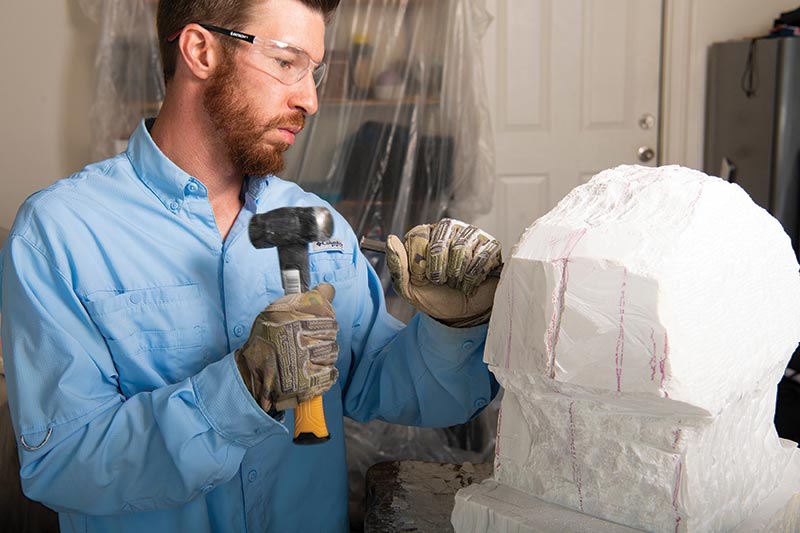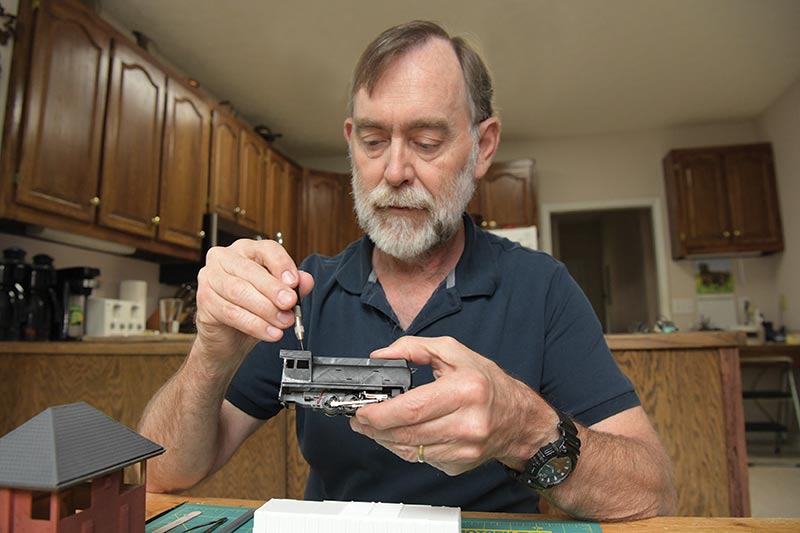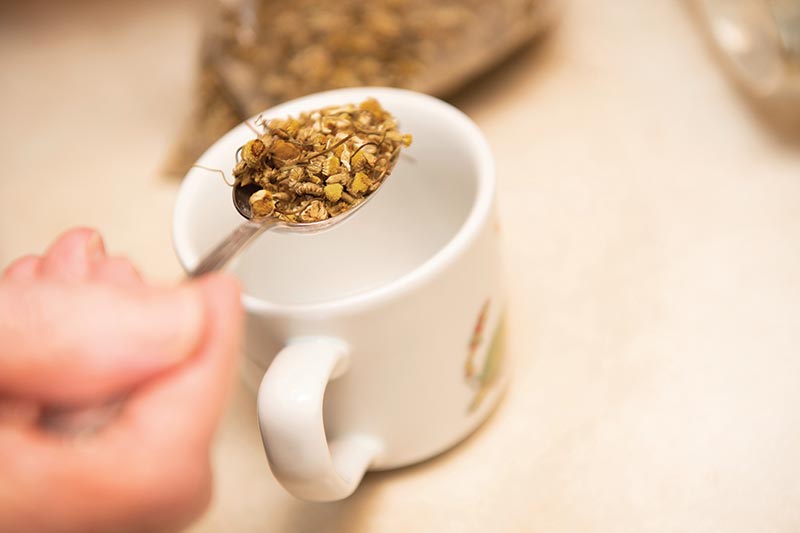Research Magazine

For many among Auburn University’s research faculty, it’s not all lab work and no play. Quite the contrary, as some enjoy unique and very diverse hobbies that reflect some exceptional talents and skills even beyond those displayed in their research endeavors.
Dr. Michael Zabala is an assistant professor of mechanical engineering and director of the Auburn University Biomechanical Engineering Laboratory, or AUBE, in the Samuel Ginn College of Engineering. His research is in biomechanics and he is focused on human performance and injury prevention. His lab aims to identify, study and help solve complex biomechanical problems in fields such as ACL injury prevention, exoskeleton technology, prosthetics and orthotics, and many others. Zabala also is a marble sculptor who says he draws his influence from the works of Michelangelo as well as his teaching and research in the field of biomechanics.



Zabala’s interest in marble sculpting began after teaching a study abroad class on biomechanics and engineering in the arts. One of Zabala's sculptures, in the likeness of his wife, Taylor, was recently exhibited at the Nunn Winston House at Kiesel Park in Auburn, Alabama.
How long have you been involved in your hobby?
I picked up this hobby last summer [2020] during the peak of the (COVID-19) pandemic.
What about your hobby interested you and how did you get started?
I teach a study-abroad class – biomechanics & engineering in the arts – that is offered to Auburn engineering students. That class is taught in Florence, Italy. It (marble sculpting) is in line with the course mechanics of materials, primarily in the context of marble. Through teaching that course, I became quite fascinated with marble sculpting. Sylacauga, Alabama, which is very near to here, is a marble quarry center. I approached a company about getting some small quantities of marble, and I was able to get some samples to work with. The quarry manager there is from Italy and very knowledgeable. The first thing I carved was a 3D representation of the shape of Italy. Human form was a topic of Renaissance marble sculpture. I have also carved a sculpture of my wife’s likeness. I used a 3D scanner on my phone to start. Then I made a clay model. I was using many engineering skills to carve. That piece took 67 days to complete, working about two hours per day. I used manual tools only.
Does your hobby require raw materials?
Marble has a minimum weight that it has to be to be carved with a hammer and chisel. If it is too light, the piece will move when struck. I have to have a piece of marble small enough that I can handle it, but that also is heavy enough to sculpt. Marble is heavy, weighing about 160 lbs./cubic foot. I have found the proper size for my work to be about 100 pounds.
Do you consider your hobby to be an expensive activity in terms of monetary investment and time?
I can’t accurately say, because I started with samples. I am able to spend about three hours each week now sculpting and I [was] one of the invited sculptors carving this year at the Sylacauga Marble Festival. Still, I [was] using free samples of my raw marble.
Does your hobby provide any benefit to others, or is this strictly an outlet for your own enjoyment/benefit/creativity?
There is something cathartic about swinging a hammer, and that is relaxing. Right now, my sculpting gives me a great deal of personal enjoyment. It also has given me much more appreciation of the art of marble sculpting and a deeper reward and enjoyment from my engineering profession and the biomechanics course that I teach. I [carved] at this year’s Marble Festival in Sylacauga, so possibly, others [got to see] and appreciate my effort also.
Do you have future expansion plans for your hobby?
I presently am using space in my garage for my sculpting. It is not the most optimum arrangement, because marble sculpting creates a great deal of dust. I hope to someday have a separate shed space that I can use for my sculpting.
Dr. Bruce Smith is a professor in the Department of Pathobiology and a scientist with the Scott-Ritchey Research Center, College of Veterinary Medicine. His current research focuses on two areas of genetic therapy, gene therapies for inherited muscular dystrophies and genetic approaches to therapy for cancer. He also is involved in research that studies molecular cascades involved in Duchenne Muscular Dystrophy and developing next-generation oncolytic viral vectors for a variety of cancers. Smith is also the director of the Auburn University Research Initiative in Cancer, or AURIC.



Smith’s locomotive models, some of which he created himself, depict trains from the year 1944. Smith’s collection includes commercially produced models and kits he has assembled and detailed. Here he works on a train with a 3D-printed shell.
How long have you been involved in your hobby?
I’ve been involved in the hobby since around age 8, so about 50 years. My interest was shelved through high school and college, although it never went completely away. My interest was recharged in graduate school and I have been actively involved ever since.
What about your hobby interested you and how did you get started
I got started by getting a train set for Christmas when I was 8 years old. I got restarted because I became interested in the history of the railroads in the Philadelphia area while I was there for veterinary and graduate school. There are really three aspects of the hobby that I find fascinating: 1) History and historical research. I love digging into references, photographs and other sources to try to find historically accurate information. I am an active member of the Pennsylvania Railroad Technical and Historical Society and serve on their Board of Directors and modeling committee. 2) Model building. I enjoy building models, whether they are railroad cars, locomotives or associated buildings. I particularly enjoy very highly detailed models, and I work to make them even more accurate. It is rare that I build an available kit without modifying it in some way. And when the model is built, I also enjoy the artistry involved in painting and weathering a model to make it look realistic. 3) Operations. I find a great deal of pleasure in operating model trains in a way that duplicates the way full-sized railroads work. Trying to figure out how to deliver the correct railroad car to the correct siding is an intellectual puzzle, with what I like to call a high “gaming” value for me.
Does your hobby require raw materials?
It can, and that can be part of the fun. Models come in many types, ranging from “ready to run,” which means that you can take it out of the box, put it on the rails and run it – to “kits” where a manufacturer provides the needed pieces – to “scratch-built,” where you take raw materials such as plastic, metal or wood, and build a model from that. It can be a real challenge to build a train car or scale building from the raw materials, but there is a great deal of satisfaction in seeing the pieces come together. These days, even “ready to run” models get some additional details or modifications from me, and I almost never build a kit strictly according to the directions.
Do you consider your hobby to be an expensive activity in terms of monetary investment and time?
One of the really neat things about model railroading is that when you are done building a kit, you aren’t done. The enjoyment of the car isn’t just in the building, but also in operating it. Some components of the hobby can be expensive. A “ready to run” locomotive model, with the latest electronic control and sound can cost up to $500. Highly detailed car kits can cost anywhere from $30 to $75, depending on the complexity and size of the car. The supplies for a scratch-built car can be scavenged and, therefore, free, but even if you order the raw materials, their cost is pretty low, and very nice models can be built for under $20. I generally spend an average of 10-15 hours building, painting and weathering each model. Some models can take upwards of 30 hours or more. I consider that time very well spent.
Does your hobby provide any benefit to others, or is this strictly an outlet for your own enjoyment/benefit/creativity?
Model railroading is often used in places like children’s hospitals and rehabilitation centers to provide hands-on activities to both entertain and provide therapy – mental, physical, social – for patients. I hope to be able to become involved in this type of activity.
Do you have future expansion plans for your hobby?
I currently have more than 200 kits to build, so that will last me for quite a few years. However, I do not have a layout on which I can run them, so that is a major future goal.
Dr. Vitaly Vodyanoy is an Alumni Professor in the Department of Anatomy, Physiology and Pharmacology, College of Veterinary Medicine. He is known for his research that has greatly improved the field of high-resolution light microscopy. His research also is focused on sensory physiology, receptors, cancer cells, biosensors, cell membranes, monolayers and bilayers, molecular recognition, olfactory receptor neurons, nanoparticles, biopolymers, bacteriophages, the primo-vascular system and light microscopy. Vodyanoy also links his study and interest in herbal medicine to his work.



Vodyanoy's hobby of studying plant and herbal remedies for his personal use began in his native Russia. As part of his hobby, he makes tea from dried chamomile flowers and raises aloe vera plants in his backyard greenhouse. He notes individuals should always consult a doctor before trying plant-based remedies.
How long have you been involved in your hobby?
I have been interested in herbs for as long as I can remember. Later in life, living in Saint Petersburg, Russia, I made trips to local fields and forests to collect herbs and mushrooms. I have lived in Auburn for the last 32 years, and I continue my devotion to studying the medicinal properties of herbs.
What about your hobby interested you and how did you get started?
As a kid, I was fascinated with herbs, their variety, flowers and the magic they could bring to our life. Later, I got curious about their abilities to replace drugs to treat various conditions such as colds, headaches or sleeplessness.
Does your hobby require raw materials?
It does require herbs. Long ago I was able to pick up wild herbs, but now it is prohibited to collect anything in public places. I obtain my plants from herbal companies.
Do you consider your hobby to be an expensive activity in terms of monetary investment and time?
Herbs are not cost prohibitive and it doesn’t take a lot of time. I spend about two hours each week studying herbal medicine.
Does your hobby provide any benefit to others, or is this strictly an outlet for your own enjoyment/benefit/creativity?
I hope it will be useful in the future. So far, it benefits my research in the college. According to ancient sources, herbs were able to cure serious illnesses, like diabetes, cancer and many other diseases. I spent some time studying works of ancient masters and have been able to reproduce some of their preparations: Galen (129-199 AD), Avicenna (980-1037 AD), Hieronymus Braunschweig (1450-1512) and Paracelsus (1493-1541). I was interested in methods they used in their preparations. It was very difficult to reproduce Galen’s and Braunschweig’s preparations, because they use dew from the growing plant as a water. They produced alcohol from the same plants. However, if I used regular pure water and alcohol, I was able to reproduce some of Galen’s preparations. I was very much interested in Paracelsus’ method, because it was best described in his books. I cannot give many details, but the method included water and alcohol extractions, calcination, carbonization in open flame, extraction, evaporation and exaltation. I reproduced the Paracelsus experiment in my improvised environment. When this Paracelsus preparation was analyzed by electron microscopy, energy-dispersive X-ray spectroscopy and electron diffraction, it revealed large concentrations of small metal nanoparticles of iron, zinc, gold, platinum and many other metals. In my laboratory, I replaced Paracelsus’ method by centrifugation, ultra-filtration and other contemporary techniques and was able to get the same metal nanoparticles. I was able to obtain metal nanoparticles from plants, cell tissues and blood samples. Then, we found that a cocktail of these particles could kill cancer cells, and in 2005 we published these results. I consider this publication to have been inspired by my hobby and Paracelsus’ ideas. Later, we published quite a few articles and generated a few U.S. patents using these nanoparticles. Finally, we learned how to make these nanoparticles from pure metals (plants and tissues are not involved). There is a company in the United Kingdom that is going to test our particles for medicinal purposes.
Do you have future expansion plans for your hobby?
No, I just plan to continue enjoying studying herbs and searching for new ideas from them.

